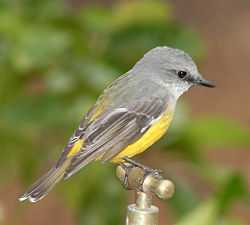Petroicidae
| Petroicidae | |
|---|---|
 | |
| Scarlet Robin, Knocklofty Reserve, Hobart, Tasmania | |
| Scientific classification | |
| Kingdom: | Animalia |
| Phylum: | Chordata |
| Class: | Aves |
| Order: | Passeriformes |
| Suborder: | Passeri |
| Family: | Petroicidae Mathews, 1919-20 |
| Genera | |
|
see text. | |
 | |
| Global range (In red) | |
The bird family Petroicidae includes roughly 45 species in about 15 genera. All are endemic to Australasia: New Guinea, Australia, New Zealand and numerous Pacific Islands as far east as Samoa. For want of an accurate common name, the family is often called the Australasian robins. Within the family the species are known not only as robins but as scrub-robins and flycatchers. They are, however, only distantly related to the Old World family Muscicapidae (to which other species with such names belong) and the monarch flycatchers (Monarchidae).
Characteristics
Most species have a compact build with a large, rounded head, a short, straight bill, and rounded wingtips. They occupy a wide range of wooded habitats, from subalpine to tropical rainforest, and mangrove swamps to semi-arid scrubland. All are primarily insectivorous, although a few supplement their diet with seeds. Hunting is mostly by perch and pounce, a favoured tactic being to cling sideways onto a treetrunk and scan the ground below without moving.
Social organisation is usually centered on long-term pair-bonds and small family groups. Most members of the subfamily Eopsaltrinae practice cooperative breeding, with all family members helping defend a territory and feed nestlings.
Nests are cup-shaped, usually constructed by the female, and often placed in a vertical fork of a tree or shrub. Many species are expert at adding moss, bark or lichen to the outside of the nest as camouflage, making it very difficult to spot, even when it is in a seemingly prominent location.
Systematics
Although named after true robins, the Petroicidae robins, along with many other insect-eating birds, were classified as flycatchers in a huge family Muscicapidae,[1] before being placed in their own family or with the whistler family Pachycephalidae.[2]
The relationship of the Petroicidae to other bird families is uncertain; Sibley and Alquist's DNA-DNA hybridisation studies had placed them in the Corvoidea (a large group that includes the shrikes, crows and jays, butcherbirds, woodswallows, drongos, cuckoo-shrike, fantails, monarch flycatchers and others).
In a more recent genetic study, they and several other families came out quite differently. They seem to form a distinct lineage of uncertain relationships, possibly as an early offshoot of Passerida diverging some 44 million years ago. However, all that can be said at present with reasonable certainty is that they are neither core Passerida ("advanced" songbirds) nor a very ancient songbird group.[3]
Acknowledging their position is unclear, current consensus places them as basal Passerida.[4]
Classification
A comprehensive review, including an analysis of the osteological characters, by Schodde and Mason in 1999 illustrated three groupings, classified as subfamilies below:[5] Testing of mitochondrial and nuclear DNA revealed some changes, and proposed sinking of Tregellasia into Eopsaltria as the White-breasted Robin's closest relatives appear to be the two taxa of Tregellasia.[6]
FAMILY: PETROICIDAE
- Subfamily: Drymodinae
- Genus: Amalocichla - 2 species.
- Genus: Drymodes - 2 species.
- Subfamily: Eopsaltriinae
- Genus: Heteromyias - 2 species,
- Genus: Poecilodryas - 6 species.
- Genus: Tregellasia - 2 species.
- Genus: Eopsaltria - 3 species.
- Genus: Peneoenanthe
- Mangrove Robin, Peneoenanthe pulverulenta
- Genus: Peneothello - 4 species.
- Genus: Melanodryas - 2 species.
- Subfamily: Petroicinae
- Genus: Pachycephalopsis - 2 species.
- Genus: Eugerygone
- Garnet Robin, Eugerygone rubra
- Genus: Petroica - 11 species.
- Genus: Microeca - 7 species.
- Genus: Monachella
- Torrent Flyrobin, Monachella muelleriana
-

Jacky Winter (Microeca fascinans)
-

Grey-headed Robin (Heteromyias albispecularis)
-

White-browed Robin (Poecilodryas superciliosa)
-

Western Yellow Robin (Eopsaltria griseogularis)
-

Hooded Robin (Melanodryas cucullata)
-

New Zealand Robin (Petroica australis)
-
Rose Robin (Petroica rosea)
-

North Island Robin (Petroica longipes)
-
Mangrove Robin (Peneoenanthe pulverulenta)
-
Pale-yellow Robin (Tregellasia capito )
References
- ↑ Boles, p. xv
- ↑ Boles, p. 35
- ↑ Barker, F. Keith; Cibois, Alice; Schikler, Peter A.; Feinstein, Julie & Cracraft, Joel (2004). PDF fulltext "Phylogeny and diversification of the largest avian radiation" (pdf). PNAS 101 (30): 11040–45. doi:10.1073/pnas.0401892101. PMC 503738. PMID 15263073. Retrieved 2008-08-14.
- ↑ Christidis L, Boles WE (2008). Systematics and Taxonomy of Australian Birds. Canberra: CSIRO Publishing. p. 175. ISBN 978-0-643-06511-6.
- ↑ Schodde R, Mason IJ (1999). The Directory of Australian Birds : Passerines. A Taxonomic and Zoogeographic Atlas of the Biodiversity of Birds in Australia and its Territories. Collingwood, Australia: CSIRO Publishing. ISBN 0-643-06456-7.
- ↑ Loynes, Kate; Joseph, Leo; Keogh, J. Scott (2009). "Multi-locus phylogeny clarifies the systematics of the Australo-Papuan robins (Family Petroicidae, Passeriformes)". Molecular Phylogenetics and Evolution 53 (1): 212–19. doi:10.1016/j.ympev.2009.05.012.
- Del Hoyo, J.; Elliot, A. & Christie D. (editors). (2007). Handbook of the Birds of the World. Volume 12: Picathartes to Tits and Chickadees. Lynx Edicions. ISBN 978-84-96553-42-2
- Mathews, G. M. (1920): The Birds of Australia Vol. VIII, No. 4.
- Miller, Hilary C. & Lambert, David M. (2006): A molecular phylogeny of New Zealand’s Petroica (Aves: Petroicidae) species based on mitochondrial DNA sequences. Molecular Phylogenetics and Evolution 40(3): 844-855. doi:10.1016/j.ympev.2006.04.012 (HTML abstract)
Cited text
- Boles, Walter E. (1988). The Robins and Flycatchers of Australia. Sydney: Angus & Robertson. ISBN 0-207-15400-7.
External links
- Petroicidae videos on the Internet Bird Collection
- Meliphagoidea - Highlighting relationships of Maluridae on Tree Of Life Web Project
| Wikimedia Commons has media related to Petroicidae. |


